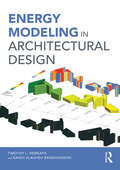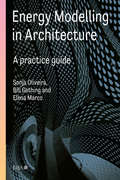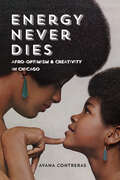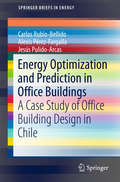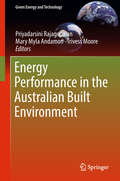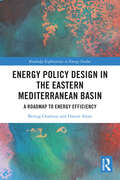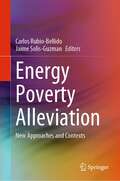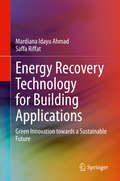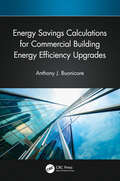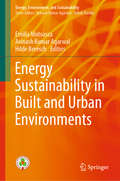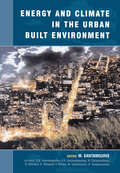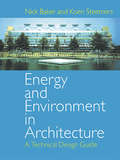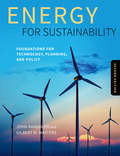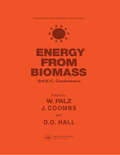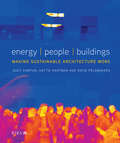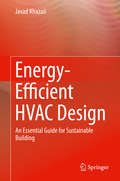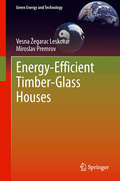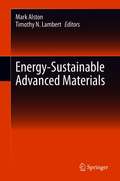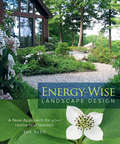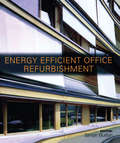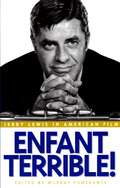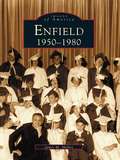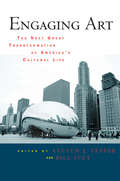- Table View
- List View
Energy Modeling in Architectural Design
by Timothy L. Hemsath Kaveh Alagheh BandhosseiniEnergy Modeling in Architectural Design demonstrates how design elements can lead to energy savings, to help you reduce the energy footprint of your buildings. In addition to identifying climate opportunities, you#65533;ll also learn fundamental passive design elements for software-agnostic energy modeling of your projects from conception. Using parametric models and testing each element during design will lead you to create beautiful and high-performance buildings. Illustrated with more than 100 color images, this book also includes a pattern guide for high-performance buildings, discusses energy and daylighting optimization, and has a glossary for easy reference.
Energy Modelling in Architecture: A practice guide
by Sonja Oliviera Bill Gething Elena MarcoThis book offers a practical guide to embedding energy modelling in architectural practice. With expert contributions from leading architects and practices, this book illustrates architects’ approaches to learning, sharing and integrating energy modelling across a range of design projects, in both small and large firms in the UK and internationally. Discussing the practical and business implications of embedding energy modelling in practice, this is an essential manual for the energy-literate architect.
Energy Never Dies: Afro-Optimism and Creativity in Chicago
by Ayana ContrerasFrom Afro Sheen to Theaster Gates and from Soul Train to Chance the Rapper, Black Chicago draws sustenance from a culture rooted in self-determination, aspiration, and hustle. In Energy Never Dies, Ayana Contreras embarks on a journey to share the implausible success stories and breathtaking achievements of Black Chicago's artists and entrepreneurs. Past and present generations speak with one another, maintaining a vital connection to a beautiful narrative of Black triumph and empowerment that still inspires creativity and pride. Contreras weaves a hidden history from these true stories and the magic released by undervalued cultural artifacts. As she does, the idea that the improbable is always possible emerges as an indestructible Afro-Optimism that binds a people together. Passionate and enlightening, Energy Never Dies uses the power of storytelling to show how optimism and courage fuel the dreams of Black Chicago.
Energy Optimization and Prediction in Office Buildings: A Case Study Of Office Building Design In Chile (SpringerBriefs in Energy)
by Carlos Rubio-Bellido Alexis Pérez-Fargallo Jesús Pulido-ArcasThis book explains how energy demand and energy consumption in new buildings can be predicted and how these aspects and the resulting CO2 emissions can be reduced. It is based upon the authors’ extensive research into the design and energy optimization of office buildings in Chile. The authors first introduce a calculation procedure that can be used for the optimization of energy parameters in office buildings, and to predict how a changing climate may affect energy demand. The prediction of energy demand, consumption and CO2 emissions is demonstrated by solving simple equations using the example of Chilean buildings, and the findings are subsequently applied to buildings around the globe.An optimization process based on Artificial Neural Networks is discussed in detail, which predicts heating and cooling energy demands, energy consumption and CO2 emissions. Taken together, these processes will show readers how to reduce energy demand, consumption and CO2 emissions associated with office buildings in the future. Readers will gain an advanced understanding of energy use in buildings and how it can be reduced.
Energy Performance in the Australian Built Environment (Green Energy and Technology)
by Trivess Moore Priyadarsini Rajagopalan Mary Myla AndamonThis book examines energy efficiency in the Australian built environment and presents current developments with a particular focus on the temperate setting of Victoria state. It is divided into four main parts discussing policies, climate, and carbon footprint and presenting case studies on the energy performance and indoor environmental quality of various building types. The book is intended for readers wanting to understand the various policies related to different buildings types and their energy performance.
Energy Policy Design in the Eastern Mediterranean Basin: A Roadmap to Energy Efficiency (Routledge Explorations in Energy Studies)
by Bertug Ozarisoy Hasim AltanThis book explores energy consumption and thermal comfort in the social housing sector in the Eastern Mediterranean basin. This book presents a novel methodological framework for the optimisation of post-war social housing developments in the Eastern Mediterranean climate. The authors draw on semi-structured interviews to present evidence on in situ thermal sensation and provide the results of walk-through and walk-in thermographic surveys to highlight building-fabric performance and highlight anomalies in the building envelopes. The authors go on to show how this data-informed retrofit design solution can be applied to reduce household energy consumption, increase awareness of domestic energy use and inform effective policymaking decisions in energy use in the Eastern Mediterranean basin, including the development of Energy Performance Certificate schemes. This book will be of great interest to students and scholars of energy policy, energy efficiency and planning. It will also assist architects, building engineers and other practitioners in closing the gap between the current understanding and the actual performance of existing residential building stocks in the Eastern Mediterranean basin.
Energy Poverty Alleviation: New Approaches and Contexts
by Carlos Rubio-Bellido Jaime Solis-GuzmanThis book presents research on energy poverty alleviation, approaching the complex phenomenon topic holistically and with heterogeneity. It includes contributions from research teams studying the topic at a national, regional and local levels worldwide. The book is divided in two main blocks. The first part, New Approaches, involves novel assessments and concepts from a global and multidisciplinary point of view. The second part, Contexts, offers new theoretical diagnoses focused on case studies of different scales from around the world, and concepts for future trends. Energy Poverty Alleviation will be of interest to policy makers, stakeholders, academics and researchers with knowledge in the energy poverty field.
Energy Recovery Technology for Building Applications: Green Innovation towards a Sustainable Future
by Mardiana Idayu Ahmad Saffa RiffatThis book discusses energy recovery technology, a green innovation that can be used in buildings. This technology reduces energy consumption in buildings and provides energy savings to conventional mechanical ventilation systems. Divided into eight chapters, the book provides in-depth technical information, state-of-the-art research, and latest developments in the energy recovery technology field. Case-studies describe worldwide applications of energy recovery technology and its integrated system for building services. This book will be used as a general and technical reference book for students, engineers, professionals, practitioners, scientists, and researchers seeking to reduce energy consumption of buildings in various climatic conditions.Presents an overview of energy consumption scenarios in buildings and the needs for energy-efficient technologies at regional and global levels;Explains models and methods of energy recovery technology performance evaluation;Inspires further research into energy recovery technology for building applications.
Energy Savings Calculations for Commercial Building Energy Efficiency Upgrades
by Anthony J. BuonicoreCode-compliant building materials and equipment will typically have a lower initial cost; however, the lifetime energy savings of the high efficiency equipment will often justify the upfront cost premium and result in a more cost-effective solution. Energy Savings Calculations for Commercial Building Energy Efficiency Upgrades assists energy professionals, contractors, building owners, and managers in developing energy savings estimates that can facilitate a quick assessment of the potential energy savings that might be realized when replacing existing building components with the highest efficiency equipment. It also provides algorithms to estimate greenhouse gas emission reductions that may be achieved by building energy efficiency upgrades and the impact these upgrades can have on building electrification-decarbonization projects. This book: Focuses on the development of energy savings estimates based upon a whole building’s energy consumption and the energy consumption associated with building end-uses such as space heating, space cooling, ventilation, lighting, and so forth. Includes over 70 illustrative examples using algorithms to demonstrate how energy savings and greenhouse gas emission reductions may be estimated utilizing different strategies and equipment.
Energy Sustainability in Built and Urban Environments (Energy, Environment, and Sustainability)
by Avinash Kumar Agarwal Emilia Motoasca Hilde BreeschThis book covers different aspects of energy sustainability in residential buildings and neighborhoods, starting from the construction and design aspects, and moving on to HVAC systems and lighting, and the applications, harvesting, use and storage of renewable energy. The volume focuses on smart and sustainable use of energy, discussing both the technological advancements and the economic, social and environmental impacts. Novel approaches to recycling of waste and materials in the context of residential buildings are also presented. This volume will be of interest to researchers and policy makers working in the fields of renewable energy, sustainable design and city planning.
Energy Sustainability in Built and Urban Environments (Energy, Environment, and Sustainability)
by Avinash Kumar Agarwal Emilia Motoasca Hilde BreeschThis book covers different aspects of energy sustainability in residential buildings and neighborhoods, starting from the construction and design aspects, and moving on to HVAC systems and lighting, and the applications, harvesting, use and storage of renewable energy. The volume focuses on smart and sustainable use of energy, discussing both the technological advancements and the economic, social and environmental impacts. Novel approaches to recycling of waste and materials in the context of residential buildings are also presented. This volume will be of interest to researchers and policy makers working in the fields of renewable energy, sustainable design and city planning.
Energy and Climate in the Urban Built Environment: Energy And Climate In The Urban Built Environment (BEST (Buildings Energy and Solar Technology))
by M. Santamouris D. N. Asimakopoulos V. D. Assimakopoulos N. Chrisomallidou N. Klitsikas D. Mangold P. Michel A. TsangrassoulisBoth the number and percentage of people living in urban areas is growing rapidly. Up to half of the world's population is expected to be living in a city by the end of the century and there are over 170 cities in the world with populations over a million. Cities have a huge impact on the local climate and require vast quantities of energy to keep them functioning. The urban environment in turn has a big impact on the performance and needs of buildings. The size, scale and mechanism of these interactions is poorly understood and strategies to mitigate them are rarely implemented. This is the first comprehensive book to address these questions. It arises out of a programme of work (POLISTUDIES) carried out for the Save programme of the European Commission. Chapters describe not only the main problems encountered such as the heat island and canyon effects, but also a range of design solutions that can be adopted both to improve the energy performance and indoor air quality of individual buildings and to look at aspects of urban design that can reduce these climatic effects. The book concludes with some examples of innovative urban bioclimatic buildings. The project was co-ordinated by Professor Mat Santamouris from the University of Athens who is also the editor of the book. Other contributions are from the University of Thessaloniki, Greece, ENTPE, Lyons, France and the University of Stuttgart, Germany.
Energy and Environment in Architecture: A Technical Design Guide
by Nick Baker Koen SteemersA unique and revolutionary text which explains the principles behind the LT Method (2.1), a manual design tool developed in Cambridge by the BRE. The LT Method is a unique way of estimating the combined energy usage of lighting, heating, cooling and ventilation systems, to enable the designer to make comparisons between options at an early, strategic stage.In addition,Energy and Environment in Architecture the book deals with other environmental issues such as noise, thermal comfort and natural ventilation design. A variety of case studies provide a critique of real buildings and highlight good practice. These topics include thermal comfort, noise and natural ventilation.
Energy for Sustainability, Second Edition: Foundations for Technology, Planning, and Policy
by Gilbert M. Masters John RandolphThe most comprehensive textbook on this topic,Energy for Sustainability, Second Editiontakes a holistic and interdisciplinary approach to help techies and policymakers alike understand the policy and social mechanisms required to enable conversion to efficient and renewable energy that is clean, affordable, and secure. Major revisions to this edition reflect the current changes in technology and energy use and focus on new analyses, data, and methods necessary to understand and actively participate in the transition to sustainable energy.Throughout the book, analytical methods for energy and economic analysis and design give users a quantitative appreciation for and understanding of energy systems. Randolph and Masters use case studies extensively to demonstrate current experience and illustrate possibilities.
Energy from the Biomass: Third EC conference
by W. Palz J. Coombs D. O. HallThis book is based on third European Conference on Energy from Biomass held in Venice. It covers energy security, environmental aspects, relieving the overproduction in some agricultural sectors and creation of jobs in rural areas.
Energy, People, Buildings: Making sustainable architecture work
by Sofie Pelsmakers Hattie Hartman Judit KimpianEnergy performance feedback is an essential tool in addressing the current climate crisis. However, this is not simply another theoretical text about energy performance in buildings. This book is for anyone who wants to better understand how energy is used in buildings, and how to drive down operational energy use – whether you’re an architect, student, client, building services engineer, contractor, building operator or other stakeholder. Focusing on evidence from feedback on buildings in use, it explains what it takes to get them to perform as expected, as well as the reasons why they often fail. Energy, People, Buildings draws extensively on the findings of studies, UK government-funded building performance evaluations and on original research into seven case studies from across the UK and abroad that have achieved exemplary energy use through building performance feedback. Providing a clear roadmap to understanding aspects that impact building users’ comfort and satisfaction, it also outlines the factors behind energy use and how to track it across the life of a project to ensure that your building performs as intended. Case studies include: the Everyman Theatre, Liverpool; Rocky Mountain Institute Innovation Center, Colorado; and Carrowbreck Meadow, Norwich. Featured architects: AHMM, AHR, Architype, Hamson Barron Smith, Haworth Tompkins, Henning Larsen Architects and ZGF Architects.
Energy-Efficient HVAC Design
by Javad KhazaiiThis book provides readers with essential knowledge enabling the successful design of today's new energy efficient HVAC systems. The author introduces important concepts such as Knowledge Categorization, Performance Based Design Standards, and Quantification of Uncertainty in Energy Modeling for Buildings. Pivotal topics that all HVAC and architectural engineers must master in order to navigate the green building renaissance are given focused attention, including the role of renewables, air quality, automatic controls, and thermal comfort. Relevant ASHRAE standards, as well as sustainability scoring systems such as BREEAM, HQE, LEED and CASBEE are explained in depth. Armed with the material contained in this practical reference, students and practitioners alike will become more effective and prepared for engineering success.
Energy-Efficient Timber-Glass Houses
by Vesna Žegarac Leskovar Miroslav PremrovThe book discusses combining timber and glass, two eco materials, with a view to developing an optimal contemporary energy-efficient house with an attractive design. Furthermore, the book connects an architectural design approach with structural research to show the possibilities of stabilizing the building with an increased size of the glazing. Research results where the glazing is considered as a load-bearing structural element are therefore presented in a manner leading to the development of an optimal model of the timber-glass house, considering both the structural and energy related aspects. The presented research work can be useful to designers and future experts in their planning of optimal energy-efficient timber buildings. The study is based on using timber and glass, which were previously neglected as construction materials. With suitable technological development and appropriate use, they are nowadays becoming essential construction materials as far as energy efficiency is concerned. However, their combined use is extremely complicated, from both the constructional point of view as well as from that of energy efficiency and sets multiple traps for designers. A good knowledge of their advantages and drawbacks is thus vitally important, which is shown in the present monograph. Energy-efficient timber-glass houses was selected by the Slovenian National Research Agency as an extraordinary scientific achievement in the field of technical sciences/civil engineering for the year 2013.
Energy-Sustainable Advanced Materials
by Mark Alston Timothy N. LambertThis book highlights progress towards the capture, storage, and utilization of energy through the development of advanced materials and systems based on abundant elements, materials, and commodities. Energy is critical to human sustainability and a global-scale deployment of renewable energy systems will be required. Hence, the chapters integrate the fundamental aspects that enable the technical advancements in detail, along with an emphasis on the need for highly sustainable materials to enable real impact for humankind: To determine innovation of energy capture and storage through characterizations of materials in areas of electrical generation and electrical storage systems; To demonstrate better performance, economic and environmental advantages than the current state of the art; To define new chemistries and materials for innovations in energy density design through lower operational temperatures, improve safety, expanding operational voltage, battery durability lifetimes, and reduce system costs. Advances critical technical and commercial objectives for novel high energy density materials;Evaluates operational material models for optimizing energy capture that are integrated by configurations as a system; Illustrates utilization of material life cycle assessment for high energy outputs generators for sustainable materials.
Energy-Wise Landscape Design
by Sue ReedResidential consumption represents nearly one quarter of North America's total energy use and the average homeowner spends thousands of dollars a year on power bills. To help alleviate this problem, Energy-Wise Landscape Design presents hundreds of practical ways everyone can save money, time, and effort while making their landscapes more environmentally healthy, ecologically rich, and energy efficient.Combining general guidelines with tips, techniques, and actions, this fully illustrated guide explains the many opportunities our landscapes provide for conserving energy. Readers will learn how to: Lower a home's heating and cooling costs Minimize fuel used in landscape construction, maintenance, and everyday use Choose landscape products and materials with lower embedded energy costs Make a positive difference without a major investment or change in lifestyle Intended for homeowners, gardeners, landscape professionals, and students, the design ideas in this book will work in every type of setting--large or small, hilly or flat, urban or rural. Written in non-scientific language with clear explanations and an easy conversational style, Energy-Wise Landscape Design is an essential resource for everyone who wants to shrink their energy footprint while enhancing their property and adding value to their home.Sue Reed is a registered landscape architect and a specialist in ecological landscape design who has helped hundreds of homeowners create comfortable, livable, and beautiful landscapes that save energy. She is also an experienced writer and teacher whose work specifically focuses on environmentally sound, energy-efficient, and sustainable landscape design.
Energy-efficient Office Refurbishment: Designing for Comfort
by Simon Burton Marco SalaLittle has been published on the subject of energy-efficient refurbishment of offices, despite the growing need to refurbish older office building stock throughout Europe, and the global requirement to conserve energy. The book suggests the most energy efficient and environmentally friendly way to refurbish offices using examples of real buildings and designs wherever possible. Each case study includes a building description, the retrofitting strategy, passive and low energy technologies used, energy assessment, comfort and environment assessment, financial assessment, client and market assessment, and conclusion. This practical design manual will be invaluable for architects and engineers specialising in the refurbishment of commercial buildings.
Enfant Terrible!: Jerry Lewis in American Film
by Jerry LewisThe one thing everybody knows about Jerry Lewis is that he is beloved by the French, those incomprehensible hedonistic strangers across the sea. The French understand him, while in the U.S. he is at best a riddle, not one of us. Lewis is someone we take profound pleasure in excluding, if not ridiculing. Enfant Terrible! Jerry Lewis in American Film is the first comprehensive collection devoted to one of the most controversial and accomplished figures in twentieth-century American cinema. A veteran of virtually every form of show business, Lewis's performances onscreen and the motion pictures he has directed reveal significant filmmaking talents, and show him to be what he has called himself, a "total filmmaker." Yet his work has been frequently derided by American critics. This book challenges that easy reading by taking a more careful look at Lewis's considerable body of work onscreen in 16 diverse and penetrating essays. Turning to such films asThe Nutty Professor, The Ladies Man, The King of Comedy, The Delicate Delinquent, Living It Up, The Errand Boy, The Disorderly Orderly, Arizona Dream, and The Geisha Boy, the contributors address topics ranging from Lewis's on- and offscreen performances, the representations of disability in his films, and the European obsession with Lewis, to his relationship with Dean Martin and Lewis's masculinity. Far from an out of control hysteric, Enfant Terrible! instead reveals Jerry Lewis to be a meticulous master of performance with a keen sense of American culture and the contemporary world. Contributors include: Mikita Brottman, Scott Bukatman, David Desser, Leslie A. Fiedler, Craig Fischer, Lucy Fischer, Krin Gabbard, Barry Keith Grant, Andrew Horton, Susan Hunt, Frank Krutnik, Marcia Landy, Peter Lehman, Shawn Levy, Dana Polan, Murray Pomerance, and J. P. Telotte.
Enfield: 1950-1980
by James M. MalleyIn the past half-century, Enfield has undergone a transformation from a rural mill-and-farming town of fifteen thousand to a substantial suburban community of forty-five thousand. Located in the north central part of the state on the eastern side of the Connecticut River, the town once known as the Carpet City began to change when the carpet industry moved parts of its operation south and Interstate 91 was built, bringing in new businesses and new residents.Enfield: 1950-1980 traces the changing landscape of Thompsonville, Enfield, and North Thompsonville through the carpet-making days to the town's recent past. Exceptional photographs depict major highway construction and the development of the regional mall district, the destructive forces of the 1955 flood and of fires throughout the years, and the unique leaders, businesses, and events that have shaped the town of today.
Engaged Journalism: Connecting with Digitally Empowered News Audiences
by Jake BatsellExplores the changing relationship between news producers and audiences and the methods journalists can use to secure the attention of news consumers.
Engaging Art: The Next Great Transformation of America's Cultural Life
by Bill Ivey Steven J. TepperEngaging Art explores what it means to participate in the arts in contemporary society – from museum attendance to music downloading. Drawing on the perspectives of experts from diverse fields (including Princeton scholars Robert Wuthnow and Paul DiMaggio; Barry Schwartz, author of The Paradox of Choice; and MIT scholars Henry Jenkins and Mark Schuster), this volume analyzes key trends involving technology, audience demographics, religion, and the rise of "do-it-yourself" participatory culture. Commissioned by The Wallace Foundation and independently carried out by the Curb Center at Vanderbilt University, Engaging Art offers a new framework for understanding the momentous changes impacting America’s cultural life over the past fifty years. This volume offers suggestive glimpses into the character and consequence of a new engagement with old-fashioned participation in the arts. The authors in this volume hint at a bright future for art and citizen art making. They argue that if we center a new commitment to arts participation in everyday art making, creativity, and quality of life, we will not only restore the lifelong pleasure of homemade art, but will likely seed a new generation of enthusiasts who will support America’s signature nonprofit cultural institutions well into the future.
